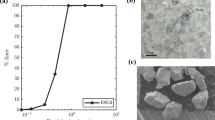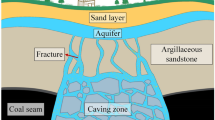Abstract
This paper numerically investigates particle saltation in a turbulent channel flow having a rough bed consisting of 2–3 layers of densely packed spheres. In this study, we combined three the state-of-the-art technologies, i.e., the direct numerical simulation of turbulent flow, the combined finite-discrete element modelling of the deformation, movement and collision of the particles, and the immersed boundary method for the fluid-solid interaction. Here we verify our code by comparing the flow and particle statistical features with the published data and then present the hydrodynamic forces acting on a particle together with the particle coordinates and velocities, during a typical saltation. We found strong correlation between the abruptly decreasing particle stream-wise velocity and the increasing vertical velocity at collision, which indicates that the continuous saltation of large grain-size particles is controlled by collision parameters such as particle incident angle, local rough bed packing arrangement, and particle density, etc. This physical process is different from that of particle entrainment in which turbulence coherence structures play an important role. Probability distribution functions of several important saltation parameters and the relationships between them are presented. The results show that the saltating particles hitting the windward side of the bed particles are more likely to bounce off the rough bed than those hitting the leeside. Based on the above findings, saltation mechanisms of large grain-size particles in turbulent channel flow are presented.
Similar content being viewed by others
References
Niño Y, García M. Gravel saltation: 2. Modeling. Water Resour Res, 1994, 30: 1915–1924
Bialik R J, Nikora V I, Rowinski P M, et al. A numerical study of turbulence influence on saltating grains. In: Dittrich A, Koll K, Aberle J Geisenhainer P, eds. Proceedings of International Conference on Fluvial Hydraulics (River Flow 2010), Braunschweig, Germany, 2010. 105–112
van Rijn L C. Sediment transport, part I: bed load transport. J Hydraul Eng-ASCE, 1984, 110: 1431–1456
Abbott J E, Francis J R D. Saltation and suspension trajectories of solid grains in a water stream. Phil Trans R Soc Lond A, 1977, 284: 225–254
Niño Y, García M H. Experiments on particle-turbulence interactions in the near-wall region of an open channel flow: implications for sediment transport. J Fluid Mech, 1996, 326: 285–319
Niño Y, García M H. Experiments on saltation of sand in water. J Hydraul Eng — ASCE, 1998, 124: 1014–1025
Niño Y, García M, Ayala L. Gravel saltation: 1. Experiments. Water Resour Res, 1994, 30: 1907–1914
Lee H Y, Hsu I S. Investigation of saltating particle motions. J Hydraul Eng — ASCE, 1994, 120: 831–845
Lee H Y, Chen Y H, You J Y, et al. Investigations of continuous bed load saltating process. J Hydraul Eng-ASCE, 2000, 126: 691–700
Lee H Y, You J Y, Lin Y T. Continuous saltating process of multiple sediment particles. J Hydraul Eng — ASCE, 2002, 128: 443–450
Ancey C, Bigillon F, Frey P, et al. Saltating motion of a bead in a rapid water stream. Physical review E, 2002, 66: 036306
Ancey C, Böhm T, Jodeau M, et al. Statistical description of sediment transport experiments. Physical Review E, 2006, 74: 011302
Osanloo F, Kolahchi M R, McNamara S, et al. Sediment transport in the saltation regime. Physical Review E, 2008, 78: 011301
Niño Y, García M. Using Lagrangian particle saltation observations for bedload sediment transport modeling. Hydrological Processes, 1998, 12: 1197–1218
Chan-Braun C, Garcia-Villalba M, Uhlmann M. Force and torque acting on particles in a transitionally rough open channel flow. J Fluid Mech, 2011, 684: 441–474
Chan-Braun C, Garcia-Villalba M, Uhlmann M. Direct numerical simulation of sediment transport in turbulent open channel flow. In: Nagel W E, Kröner D B, Resch M M, eds. High Performance Computing in Science and Engineering’10. Heidelberg: Springer, 2011. 295–306
Thomas T G, Williams J J R. The development of a parallel code to simulate skewed flow over a bluff body. J Wind Eng Ind Aero, 1997, 67–68: 155–167
Singh K M, Sandham N D, Williams J J R. Numerical simulation of flow over a rough bed. J Hydraul Eng — ASCE, 2007, 133: 386–398
Ma J, Williams J J R. Implication of horizontal force moments for the threshold of bed entrainment in an open-channel flow. J Hydroenviron Res, 2009, 3: 2–8
Peskin C S. Flow patterns around heart valves: a numerical method. J Comp Phys, 1972, 10: 252–271
Ji C, Munjiza A, Williams J J R. A novel iterative direct-forcing immersed boundary method and its finite volume applications. J Comp Phys, 2012, 231: 1797–1821
Munjiza A, Owen D R J, Bicanic N. A combined finite-discrete element method in transient dynamics of fracturing solids. Eng Comp, 1995, 12: 145–174
Munjiza A, Andrews K R F. Penalty function method for combined finite-discrete element systems comprising large number of separate bodies. Int J Numer Meth Eng, 2000, 49: 1377–1396
Xiang J, Munjiza A, Latham J P, et al. On the validation of DEM and FEM/DEM models in 2D and 3D. Eng Comp: Int J Comp-Aided Eng, 2009, 26: 673–687
Hofland B. Rock and roll, turbulence-induced damage to granular bed protections. Dissertation of the Doctoral Degree. Delft: Delft University of Technology, 2005
Defina A. Transverse spacing of low-speed streaks in a channel flow over a rough bed. In: Ashworth P J, Bennett S J, Best J L, et al., eds. Coherent Flow Structures in Open Channels. New York: Wiley, 1996. 87–99
Grass A J, Stuart R J, Mansour-Tehrani M. Vortical structures and coherent motion in turbulent flow over smooth and rough boundaries. Philos Trans R Soc London, Ser. A, 1991, 336: 33–65
Grass A J. Structural features of turbulent flow over smooth and rough boundaries. J Fluid Mech, 1971, 50: 233–255
Nezu I. Turbulence structure in an open channel flow. Dissertation of the Doctoral Degree. Kyoto: Kyoto University, 1977
Nezu I, Nakagawa H. Turbulence in Open-channel Flows. Rotterdam: Balkema, 1993
Jiménez J. Turbulent flows over rough walls. Annu Rev Fluid Mech, 2004, 36: 173–196
Ji C, Munjiza A, Avital E, et al. Direct numerical simulation of sediment entrainment in turbulent channel flow. Phys Fluids, 2013, 25: 056601
Luque R F, van Beek R. Erosion and transport of bed-load sediment. J Hydrol Res, 1976, 14: 127–144
Gordon R, Carmichael J B, Isackson F J. Saltation of plastic balls in a ‘one-dimensional’ flume. Water Resour Res, 1972, 8: 444–459
Dwivedi A, Melville B W, Shamseldin A Y, et al. Flow structures and hydrodynamic force during sediment entrainment. Water Resour Res, 2011, 47: W01509
Author information
Authors and Affiliations
Corresponding author
Rights and permissions
About this article
Cite this article
Ji, C., Ante, M., Eldad, A. et al. Numerical investigation of particle saltation in the bed-load regime. Sci. China Technol. Sci. 57, 1500–1511 (2014). https://doi.org/10.1007/s11431-014-5606-1
Received:
Accepted:
Published:
Issue Date:
DOI: https://doi.org/10.1007/s11431-014-5606-1




